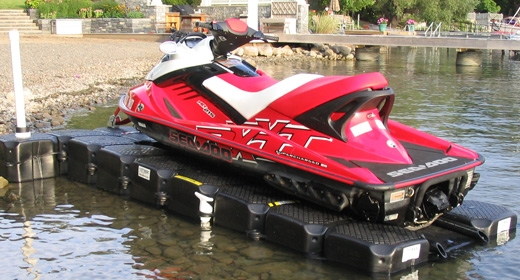One of the most depressing dates of the summer is the final day you’re able to take your Jet Ski out on the water. While your last personal watercraft (PWC) joyride is bittersweet, you need to remember to winterize a Jet Ski after your last run to ensure your favorite toy functions properly the following boating season.
The six steps below will teach all PWC owners how to winterize a Jet Ski properly and efficiently. Learning how to winterize Jet Skis is key to keeping your PWC in tip-top condition for years to come. Keep in mind that while our advice will help prep your Jet Ski or Sea-Doo for next year, we always recommend consulting your owner’s manual for your manufacturer’s specific instructions on Jet Ski winterization.
Right after you take your PWC out of the water for the season, we advise you drain the excess water from its cooling system. A Jet Ski naturally utilizes the cool water from the lake or ocean to lower the temperature of its internals.
To drain all the water, we recommend running the engine in 30-second intervals while tilting your Jet Ski’s handle back. After all the water is out of the system, we suggest flushing the cooling system to ensure all dirt, algae and grime is removed from the vessel. Again, you should follow the instructions in your owner’s manual to ensure you flush your system thoroughly as part of your regular Jet Ski winterizing process.
It’s extremely important that you clean your Jet Ski before you dock it for the season. Wash the hull of the PWC with a mild soap. After you scrub the hull, clean and wax the shell of your vehicle to protect it from UV damage and wear. Next, clean the bilge area of your PWC to wash away any excess grime.
Another important step in winterizing a Jet Ski is to fill the gas tank up to the top with a stabilizer to keep it clean. Make sure to read the directions on the stabilizer bottle before adding it into your fuel tank. You should run the engine in 30-second intervals to ensure the stabilizer is well mixed in the fuel. After stabilizing your fuel, you should lubricate all seals and cabling using a lubricant and protectant recommended by the PWC manufacturer.

Your next step in this Jet Ski winterization process is to spray the carburetor and spark plug cylinders with a fogging oil. You will need to remove the air filter from your Jet Ski in order to access these parts. Once the filter is removed, turn on the engine and spray the spark plug cylinders and carburetor while the engine is idling. You should continue to spray until the engine stalls and replace your air filter once you’re done.
When this is complete, make sure your spark plug wires are grounded and then remove the spark plugs. Spray fogging oil into each hole for a couple of seconds. We suggest placing a rag over the holes and turning the PWC on. This will allow the oil to coat the internals of the vessel. It is normal if your engine does not start. Once this is done, clean the mess you might have made and reinstall the spark plugs.
Leaving your Jet Ski battery in over the winter can reduce its charge. As part of your regular Jet Ski winterizing process, you should take the battery out of your PWC by removing the negative connection first, followed by the positive connection.
We suggest storing your Jet Ski on a trailer with the trailer wheels off for easy maintenance. You should also place some kind of noninvasive material in the exhaust to prevent animals or bugs from crawling in the engine. Believe us, this does happen! Next, cover and store your vessel in a safe spot.
The Jet Ski winterization process might seem like a lot of work. Just remember that by taking the proper steps for winterizing a Jet Ski, it will be ready to go for the opening run of the season. We also suggest investing in one of our Jet Ski docks or lifts in order to make cleaning and maintaining your PWC even easier. Jet Dock lifts are able to completely raise your vessel out of the water, preventing hull delamination and intake fouling. If you have any questions or need more information, contact us today!
By answering a few quick questions we will be able to tell you which dock or boat lift is the perfect fit for you.
Start Now! ▶